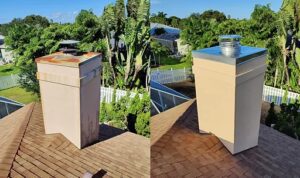Chimney Inspection
 Standard 211 of the National Fire Protection Association (NFPA) states residents should have a chimney inspection every year. Alongside your chimney inspection, you should have it cleaned if you use it regularly. Regular chimney inspections assist in protecting your home and your loved ones.
Standard 211 of the National Fire Protection Association (NFPA) states residents should have a chimney inspection every year. Alongside your chimney inspection, you should have it cleaned if you use it regularly. Regular chimney inspections assist in protecting your home and your loved ones.
The Critical Part of Your Chimney
The most critical part of your chimney is known as the chimney liner. The liner is typically made of clay or metal and performs three different jobs: protects combustible materials in the home, protects masonry from combustion, and provides the correct-sized flue for gas-burning appliances.
The liner and flue are often interchanged, but these two chimney parts are different. The chimney flue is the vertical shaft of your chimney. It propels smoke upward toward the chimney crown. The chimney liner lines the flue and is made of metal or clay. This protection is essential for the smoke to properly exit the chimney and avoid combustible materials from catching on fire.
The liner must be inspected annually to avoid health risks. If the liner is exposed or damaged, it allows smoke to renter your home, and those exposed materials may catch on fire. This creates a serious house fire that puts you and your loved ones at risk.
Three Varying Degrees of Chimney Inspections
The Chimney Safety Institue of America (CSIA) outlines three different degrees or levels of chimney inspections. These inspections are prompted by different situations associated with your chimney. The first type of inspection or level one is performed when the chimney has not seen any change. This is the typical inspection many homeowners receive.
A level one chimney inspection covers all the readily accessible chimney parts: chimney crown, firebox, flue, smoke chamber, etc. Our team will perform this inspection to ensure your flue and chimney as a whole is structurally sound. For gas chimneys, our team examines the valves and connections to ensure there are no leaks.
A level two inspection is warranted by a change in the chimney’s system. A change is considered anything between the type of fuel to the addition of a gas appliance. This type of inspection is performed when the property is sold to a new owner. This inspection performs the same as the first level but in more detail.
Finally, a level three chimney inspection is prompted by determining the condition of the chimney. The same steps in the previous levels are performed, but portions of the chimney are also removed. Special tools and procedures are needed to perform this level of inspection. You can learn more about each of these inspection levels on the CSIA website.
Over time, chimneys collect soot, ash, and creosote. Creosote is a chemical that forms when condensed in the chimney. A massive buildup of creosote can create a serious problem for your chimney. It won't work as efficiently, and it could cause a fire within the flue itself. For this reason, an annual sweeping and inspection are necessary for your health and safety.
Comprehensive Chimney Services
Fresh Air Duct Cleaning offers comprehensive chimney services for homeowners. Contact our team today for a chimney sweep, chimney inspection, chimney repair, or chimney installation. We can provide a free estimate over the phone. Maintaining the quality of your chimney assists in its efficiency and protects you and your property. Contact our team today to learn more about our services.
